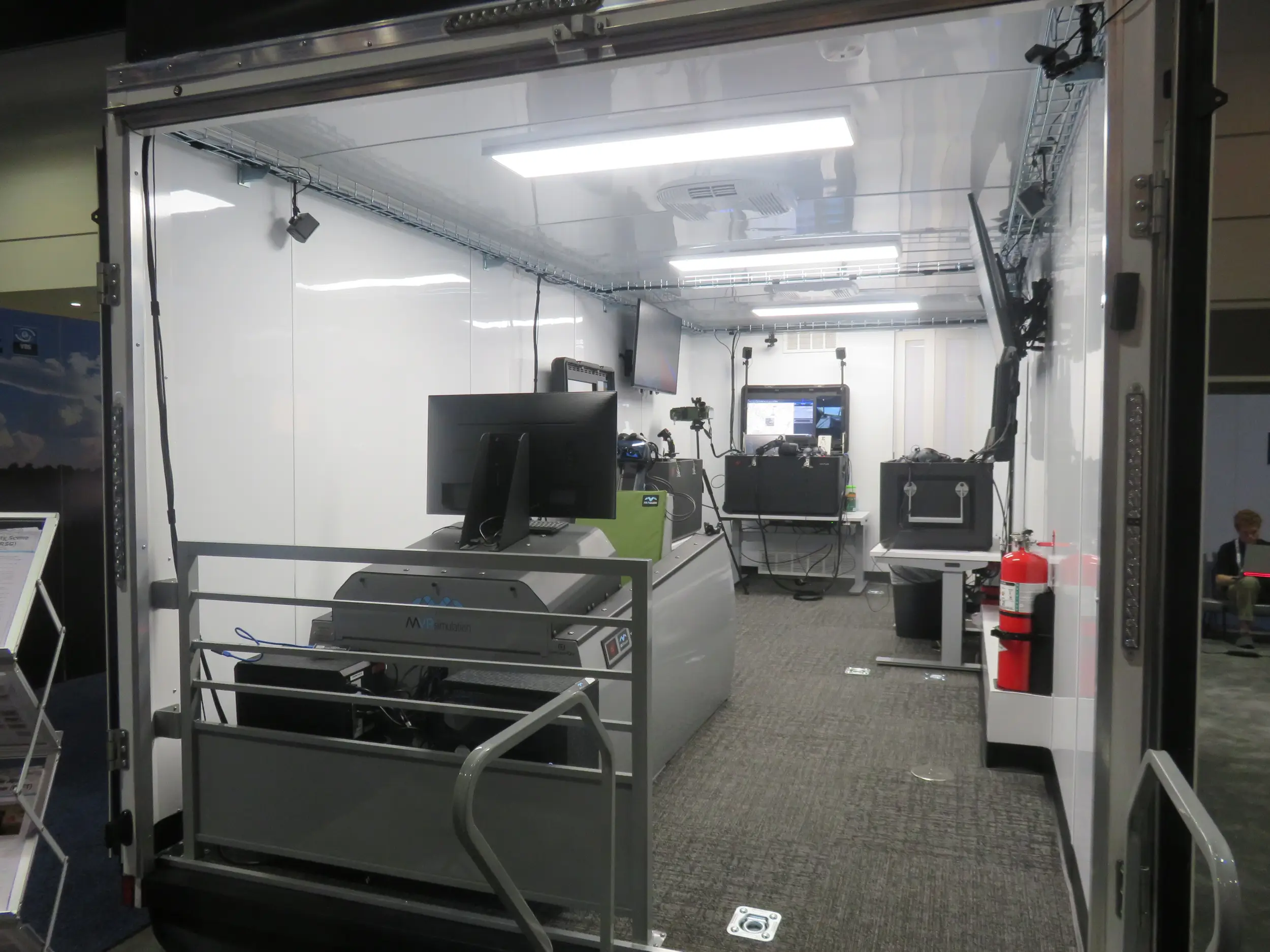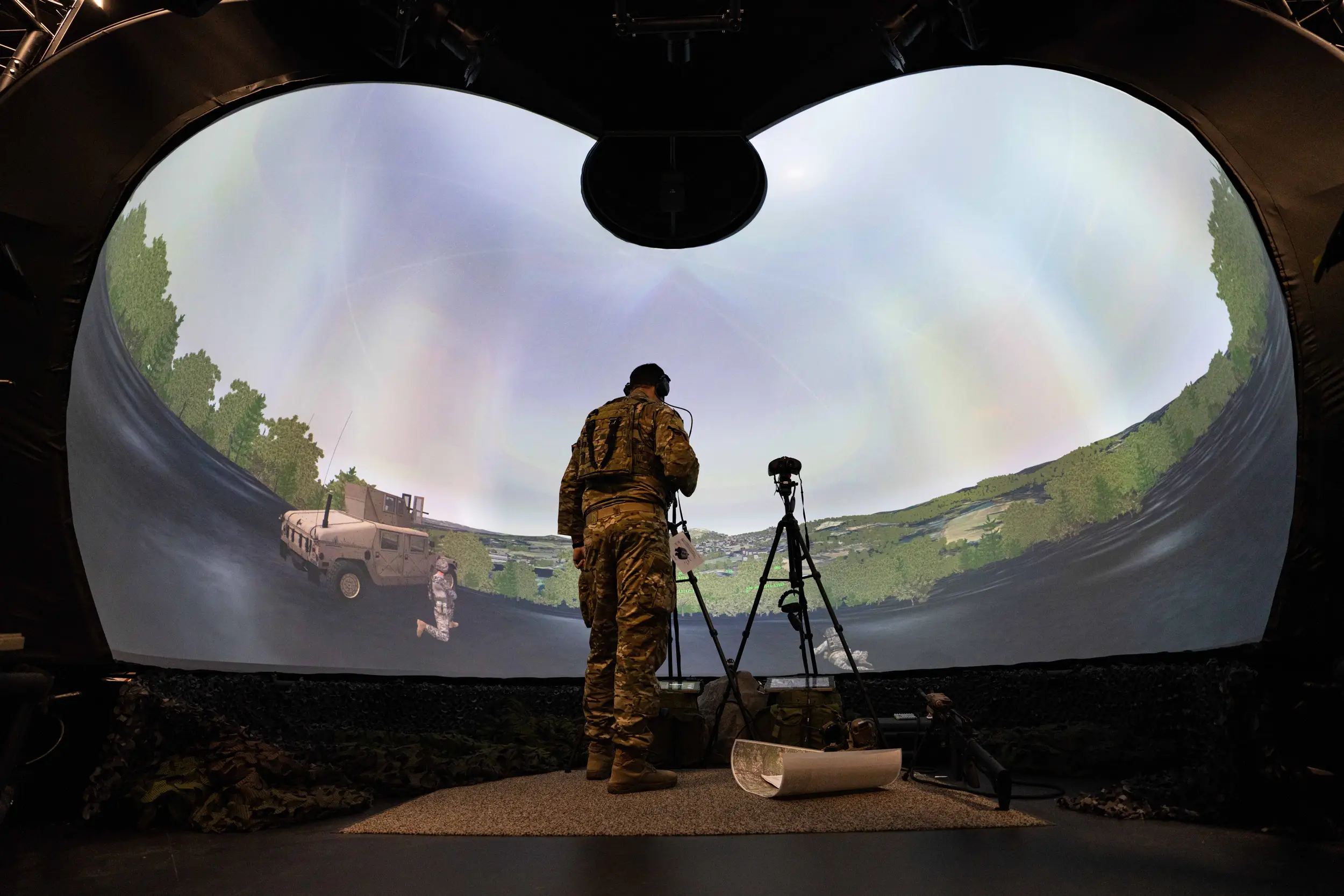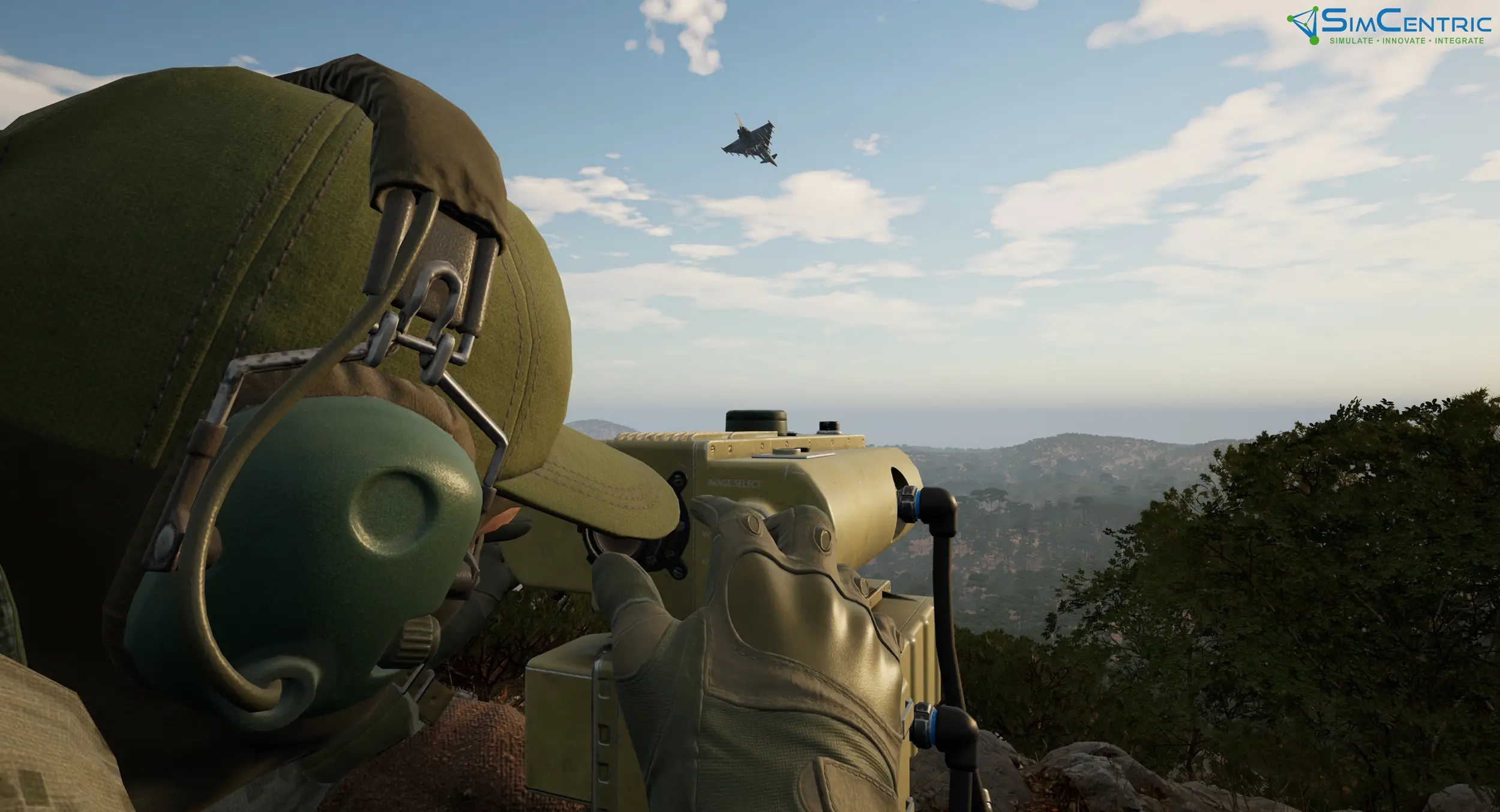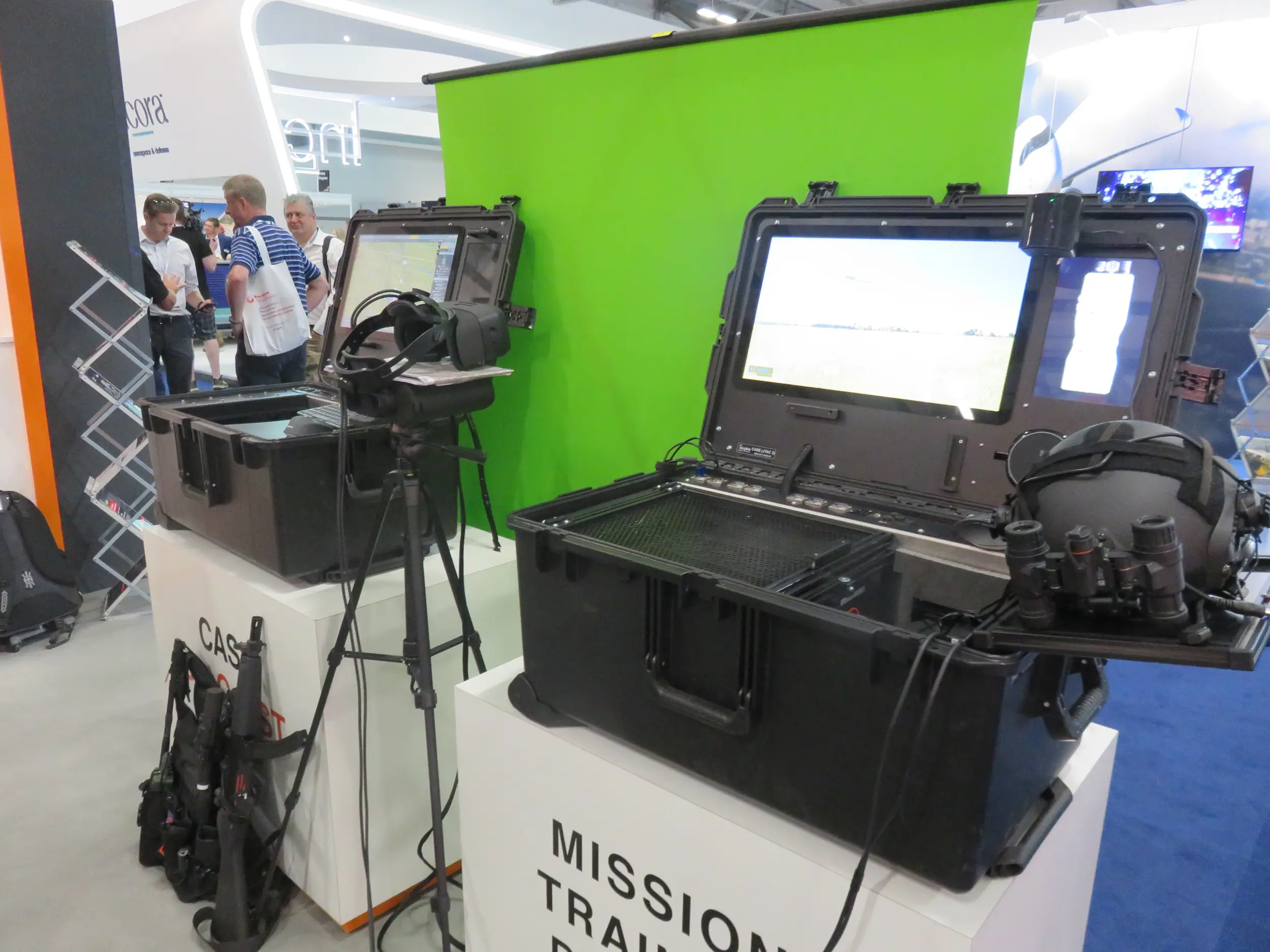
REPORT HOME > CONTROLLING INTEREST
INDUSTRY INSIGHTs report | 2023 |
The JTAC plays a vital role in directing close air support and indirect fires that can be crucial to winning a hard-fought battle on the ground. Given the complex nature of the role, its interaction with multiple assets and the need for JTACs to retain their formal qualification, how is simulation keeping these highly trained professionals combat-ready?
Above: As with most forms of live training, carrying out a JTAC qualification sortie with real aircraft requires use of expensive assets and a large range area. (Photo: USAF)
The most effective training comes from constant repetition – ‘practice makes perfect’ may be a cliché, but it remains valid. The problem in the military arena is that constant practice can require regular availability of scarce resources. Generally, this cannot realistically be achieved, which is why simulation is frequently the solution.
This is particularly the case with joint terminal attack controller (JTAC) training. JTACs provide direction for indirect fire support, particularly close air support (CAS), which can be battle-winning at a tactical level but requires accurate direction to avoid the risk of collateral damage or fratricidal engagement.
Common standard
In NATO and allied nations the JTAC role is unusual in that there is an agreed standard for qualification to control CAS, which must be maintained through regular practice.
In coalition operations, the aircraft that deliver CAS may come from one of several constituent air forces and could be directed by a JTAC from any participant nation. It is therefore crucial that all countries have faith in the skills of the controller and their standards of training and qualification.
For most Western countries the minimum standards are defined in two documents: NATO’s STANAG 3797 and the US Joint Chiefs of Staff Joint Fire Support Executive Steering Committee (JFS ESC) JTAC Memorandum of Agreement (MoA). These lay down the minimum number of successful controls a trainee must undertake to achieve qualification, and the number that must be completed annually to maintain currency.
Live aircraft are an expensive and limited resource for JTAC training, so the MoA allows the use of simulators for a proportion of controls for ab initio and currency training, providing they have been accredited as being capable of fulfilling requirements.
Until recently JTAC simulators fell roughly into two categories: static domes and laptop-based devices.
The former type provides an immersive experience, with domes varying in size from 360° down to 120°. These allow a trainee to use the auxiliary equipment associated with the role, usually in emulated form and integrated with the simulation, such as binoculars, laser target designators (LTDs), radios, the Defense Advanced GPS Receiver (DAGR), IR Zoom Laser Illuminator/Designators (IZLIDs), and Remotely Operated Video Enhanced Receiver (ROVER) terminals, as well as conventional maps and notebooks.
High-quality projectors display the synthetic environment within which the scenario is enacted and the control executed. The device can be supported by a role-playing station or integrated with flight simulators, enabling simultaneous training of pilot and JTAC.
At the other end of the scale are portable systems, sometimes associated with small flat screens; in general, JTAC equipment is provided in soft format. These simulators are useful for teaching and practising CAS procedures and can still be accredited, but they do not provide an immersive experience.
Using a VR HMD can give an immersive view of the synthetic environment. However, this does not allow the use of real (or emulated) physical equipment which is a key requirement for realistic training.
However, the advent of MR HMDs now makes it possible to leverage the benefits of portability and the cost reduction associated with dispensing with fixed facilities while enabling JTACs to use auxiliary equipment when immersed.
Mixed messages
Several similar MR solutions have appeared more or less simultaneously, all using the Varjo XR-3 HMD which uses ultra-low latency, dual 12-megapixel video pass-through and has a 115° FoV, 90Hz refresh rate and eye tracking. This allows the wearer to use physical equipment while viewing the virtual world, either through masking or green-screen technology.
MVRsimulation has been heavily involved in JTAC training for a number of years. Integrated with the Modern Air Combat Environment (MACE) from Battlespace Simulations (BSI), its Virtual Reality Scene Generator (VRSG) is fielded in over 150 UAS and JTAC training systems.
Above: The Deployable Joint Fires Trainer from MVRsimulation. From left to right: role-player station, instructor station, observer station, emulated target designator. The small mast units on the observer station support headset tracking. (Photo: MVRsimulation)
According to MVR, VRSG is ‘a Microsoft DirectX-based render engine that provides geospecific simulation as an image generator [IG] with game-quality graphics. VRSG enables users to visualise geographically expansive and detailed virtual worlds at 60Hz frame rates on commercially available PCs.’
Garth Smith, president and co-founder of MVRsimulation, told Shephard that the company uses its own 3D terrain database and it offers a range of models that covers ‘more than 90%’ of the Combat Air Force Distributed Mission Operations library. He added that additional 3D models can be provided at a customer’s request.
MACE meanwhile is a ‘holistic computer-generated/semi-automated forces (CGF/SAF) application [which] provides a physics-based DIS-enabled simulation capable of being used in a wide variety of ways, including UAS and JTAC training scenario generation and management, threat generation, mission rehearsal and part-task training’.
The VRSG/MACE combination is used in a number of applications, including the USAF Joint Terminal Control Training and Rehearsal System (JTC TRS), the USN’s Combined Arms Virtual Environment and the UAE Presidential Guard’s Joint Fires Training Simulator as well as desktop trainers such as the JTAC-TACP/Operational Simulation Suite.
Above: The observer tablet, displaying on the left the ATAK view, populated with a map and information from BSI MACE. On the right is MVRsimulation’s VRSG simulated sensor feed. (Photo: MVRsimulation)
In early 2023 the JTC TRS programme renewed 405 VRSG software maintenance licences. VRSG provides 3D real-time visuals for the system, including out-the-window geospecific terrain and sensor visuals for the dome display and simulated sensor feed for Android Tactical Assault Kit (ATAK) video receiver devices.
Deployable devices
Leveraging the MR capabilities of the Varjo XR-3, MVR has now developed the Deployable Joint Fires Trainer (DJFT) which runs VRSG and MACE. The basic system is housed in three aluminium welded transit cases containing the observer station (OS), role-player station (RPS) and instructor/operator station (IOS).
The OS includes an integrated XR-3 HMD, an emulated PEQ-1B SOFLAM LTD and an emulated IZLID 1000P. All other equipment such as DAGR, radios and ROVER are simulated in soft form.
Smith said these could also be provided as emulated hardware but ‘some things work just fine on a tablet; if you only need a 2D interface then it’s not necessary to have emulated kit. You choose according to the balance of utility.’
The HMD provides an all-round FoV and allows the observer to be immersed while interacting with physical emulations to conduct CAS controls. Head position and emulated hardware are tracked by the system, with the latter appearing as virtual entities but able to be operated as if real.
Masking enables the observer to see and use the soft simulations, and read a map or notebook. The HMD also tracks eye movement, which can be viewed live by the instructor, exported and recorded for AAR.
The IOS, which MVRsimulation software engineer Bert Haselden said can control up to seven role-players or observers, provides full dynamic control of the scenario including live and virtual entities. It generates role-player entities in the virtual world including crewed and uncrewed aircraft and ground vehicles, plus JTAC entities.
‘Some things work just fine on a tablet; if you only need a 2D interface then it’s not necessary to have emulated kit.’
The IOS includes a terrain server that holds round-earth VRSG terrain and the MACE software. It provides ‘god’s eye’ and stealth views of the OS and can communicate to all players using simulated radios. It can also generate an aircraft sensor feed for display on an emulated ROVER. The IOS will record all actions in a scenario for AAR.
The RPS provides fixed- or rotary-wing aircraft, UAS and ground vehicle activity in the mission, allowing the operator to communicate as aircrew with all players using simulated radio and to control assets either manually or using nine- and five-line formats. Like the IOS it can generate an aircraft sensor pod feed. Haselden noted that MACE also enables the operator to alternate between roles.
The stations are networked via dual internal 10-Gigabit Ethernet switches. Additionally, the DJFT can be connected to MVR’s fixed-wing part-task mission trainer (PTMT) or across an external network to remote flight simulators.
The DJFT is capable of providing training for digitally aided CAS (DACAS). According to MVR, MACE supports DACAS using real-world data link messages to execute both the Link 16/Situational Awareness Data Link and Variable Message Format message flows.
Together with VRSG’s Key-Length Value metadata these permit the seamless integration of the DJFT with real-world tablet-hosted targeting software suites such as ATAK/WinTAK, and data link message middleware such as Sierra Nevada’s TRAX/ATRAX or Teleplan Globe’s FACNAV.
A significant aspect of the use of the XR-3 HMD is that the JTAC observer wearing it can read and use ATAK (or other targeting and battle management software) on a tablet, which allows them to stay in the DJFT immersion and complete the DACAS control.
Rolling out
In June 2022 the first example of the DJFT was delivered to the USAF’s 5th Combat Training Squadron (CTS) at the USAFE-AFAFRICA Warfare Center at Einsiedlerhof in Germany, where the JTC TRS dome is located.
Speaking at the Omega Joint Training and Simulation conference in Bristol the same month, Lt Col Lee Stanford, commander 5 CTS, said that the unit’s mission was to ‘integrate distributed mission training to meet future needs’ and provide interoperability training for NATO and partner nations.
He noted that the DJFT, although not a programme of record, had the potential to provide a valuable training capability, adding that this type of trainer ‘could replace the [existing] dome in the future’.
By December 2022 interim accreditation had been granted by the JFS ESC for the Einsiedlerhof facility. This enables the DJFT to replace live terminal attack controls as authorised for certification and qualification in the JTAC MoA.
Above: The DJFT trailer-borne version launched at I/ITSEC 2022. In the foreground is the PTMT, with the role player, observer and instructor stations behind. (Photo: author)
MVR has also developed a trailer-borne version of DJFT which it exhibited at the I/ITSEC event in Orlando in December 2022. This incorporates the OS, RPS and IOS and also includes a PTMT to provide an additional role-player capability.
At I/ITSEC 22 Varjo launched a new version of the XR-3, the Focal edition, which offers improved image clarity. MVR has incorporated the new version into the DJFT and has also included a software zoom feature which simulates binoculars with discrete levels of magnification.
Since then, carbon fibre Dalcomm headsets with active listening and radio push-to-talk have been integrated. This allows the headset wearer to hear external audio as well as radio traffic, and provides the ability to isolate the observer during a mission so that the instructor and role player can communicate about the training scenario without the observer being party to the conversation. The carbon fibre design is lighter and reduces fatigue for the wearer.
Other hardware improvements include addition of internal DISA-approved network switches and the introduction of rapid-access hard drive swapping for classified drives via desktop access.
Above: Enhancements have been made to the USAFE-AFAFRICA Warfare Center’s JTAC training systems. (Photo: USAF)
The DJFT units at the USAFE-AFAFRICA Warfare Center have now been upgraded to Block 2 status, incorporating these various improvements, as part of the final delivery process. Work to achieve full accreditation and authority to operate is in progress.
Gaming tech
SimCentric has also selected the Varjo XR-3 to develop an MR JTAC version of its SAF-TAC VR training system, which was first revealed at the I/ITSEC 2021 event in Orlando.
Gareth Collier, SimCentric’s VP of strategy, told Shephard on that occasion that SAF-TAC uses the open-source Unreal Engine to take advantage of the investment made by the gaming industry. He explained that the aim is to create a system that will engage users and is portable and available at the point of need. All SAF-TAC versions use the Unreal Engine integrated OpenXR tool as standard.
Adam Easton, SimCentric founder and CEO, said that 2022 has seen the culmination of an expansion of capability across the company’s JTAC and joint fires range and it now consists of three separate software products.
FiresFST provides a JTAC and joint fires solution pre-integrated with VBS3, while SAF-FIRES offers a standards-based integration to connect with a variety of simulations and IGs. SAF-JTAC encompasses SAF-FIRES directly connected with the Unreal Engine, providing an MR-capable simulator.
He explained that SAF-JTAC supports MR purely through the XR-3’s depth-sensing capability: ‘There are no masked areas or use of chromakey technology. Instead, the sensed depth around the trainee is used to build the mixed-reality effect. This means that the system does not need green screens and that it can be easily deployed or transported to new training rooms.’
Easton added that another major new technique is using Varjo markers as trackers for emulated equipment. ‘This removes the need for positional trackers to be built into the emulated devices, making the emulated equipment significantly cheaper to design and manufacture,’ he explained.
Varjo describes the markers, which are small squares printed with black and white patterns, as ‘physical markers tracked by the video pass-through cameras on [the] XR-3… Object markers are used to track static or dynamic objects in the user environment… Each marker has a unique ID… For added precision, an application can use multiple markers to track a single object.’
Above: SimCentric uses the Unreal Engine together with its SAF-JTAC software to provide an MR training capability. (Photo: SimCentric)
A deployable version of SAF-FIRES is in use with the Australian Army for forward observer courses, using projector, desktop or HMD configurations.
At I/ITSEC 2022 Collier said that the plan for this year is to expand the capability for collective training with multiple observer stations, an ISR platform management capability and potentially OPFOR stations as well.
He noted that the advantage of the modular system is that it can be set up as four aggregated systems operating as one, either in a single location or networked from different sites, or as different combinations of systems using different scenarios.
SimCentric has also worked with infrastructure company Surbana Jurong in Singapore to deliver two MR JTAC trainers for the Singapore Armed Forces, utilising the XR-3 together with emulated equipment and automated speech recognition. The system is being used to train type 1 and 2 controls exclusively using MR.
‘Utilising the Unreal Engine alongside MR for JTAC training has sparked a lot of international interest, and SimCentric is seeing significant interest from other nations in acquiring SAF-JTAC’ Collier added.
Agile simulation
Another Varjo XR-3 user is Inzpire, which has integrated the display in its Compact Agile Simulated Equipment (CASE) JTAC trainer. First displayed at London’s DSEi exhibition in 2021 the original version was demonstrated using the masking capability.
However, at the July 2022 Farnborough air show Mark McDonnell, land JTAC business development executive for Inzpire, told Shephard that experience had shown that a wrap-around green screen was more effective and produced better graphics.
Also the XR-3 has been integrated with a new helmet and NVGs to improve its night simulation capability.
The basic system is contained in two cases, one JTAC station and one IOS; up to seven JTAC stations can be connected to an IOS. The system has been developed using BISim’s VBS4 software, known as Defence Virtual Simulation 2 in UK service, which includes BISim Fires applications. However, the system is software-agnostic and could use other virtual environments and scenario generators.
Training is conducted using pre-scripted aircraft missions or by the instructor ‘flying’ the aircraft according to the JTAC’s instructions. Their role equipment can be displayed on screen or as emulated hardware.
This includes the Eagle viewing device, a multifunctional target acquisition and surveillance emulator from Minerva which can be used to replicate several different systems, and an IZLID emulator. Viper radio simulation software provides surrogate communications.
Above: The Inzpire CASE JTAC displayed at the Farnborough International Air Show. The observer station is on the right and the IOS on the left, with the Eagle viewing device and Varjo HMD between them. (Photo: author)
McDonnell said that shortly after DSEI the equipment had been deployed to Estonia to support UK forces on Operation Cabrit who were preparing for Furious Wolf, a NATO JTAC exercise in Lithuania, where the system was used for more than 150 controls.
Subsequently, CASE JTAC was demonstrated in Jordan and put in a repeat performance for Exercise Furious Wolf 2 in May 2022.
For these training events, Inzpire provided personnel to establish and operate the system and support the exercise. McDonnell said that the likely aspiration for the CASE equipment was for an equal split of providing training as a service, and straightforward commercial sales to customers.
Service model
The advantage of the service model is guaranteed availability, provision of subject-matter experts and experienced equipment operators, and no maintenance or sustainment costs. Portable equipment lends itself to this model more easily than fixed installations.
As an established example of the model in use, in 2018 the British Army acquired the Joint Fires Mobile Trainer (JFMT) from Elbit Systems UK as a full-service capability for the then 1st Artillery Brigade, now merged into 1st Deep Recce Strike Brigade Combat Team. JFMT combines mobility with the immersive experience of a small dome and provides fully accredited CAS training.
Above: The Elbit Joint Fires Mobile Trainer has been in use with the British Army since 2018. (Photo: UK MoD/Crown Copyright)
The system consists of a trainee station, IOS and pilot station in a 20ft trailer. It uses the VBSBlue IG integrated with MACE to generate scenarios. The trainee station is a 1.8m dome with a 220x58° screen from Immersive Display Systems. It is integrated with a range of emulated equipment and DACAS capability is supported by ATAK.
The IOS handles scenarios and virtual environmental conditions and maintains a full record of each control. There is a small briefing area at the end of the trailer for AAR. The pilot station can fly a virtual aircraft in support of the mission and provides human interaction with the JTAC, giving the instructor an entity independent of the CGF. The pilot station can also be used for other role players.
Elbit maintains and deploys the JFMT and delivers the training as required by its army customer.
With the JTAC’s need to regularly train to maintain qualification for a complex set of tasks, industry is clearly stepping up to the plate in the variety and sophistication of simulators and other devices on offer, with the MR headset being a real game-changer in terms of level of immersion.
This independent reporting was made possible with the support of MVRsimulation.





